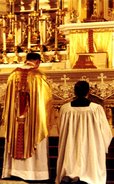A Novus Ordo Mass Celebrate Ad Orientum at Assumption Grotto Parish, Detriot Michigan
All too often, the case made for ad orientem is a technical one (i.e., never abrogated). I believe we need to start talking more deeply about the profound spiritual nature of the posture, and what it fosters interiorly. Catechesis without this aspect will never be as effective. More will embrace it as they comprehend just how spiritual it is - for both priest and worshipers.
It is in interior silence - the quiet - that we discover God, and ultimately our relationship with Him. The Mass - of all things - must enable this, not hinder it. The loud, busy Masses I have experienced for the first 43 years of my life have never caused me to humble myself before the Lord the way the quiet, reserved Masses at Assumption Grotto have over the last year-and-a-half. There are many subtle cues which bring this about, which all together make for a reserved, solemn liturgy. Couple that with good sermons which talk about ALL matters of our faith - the comfortable ones, and the not so comfortable ones, and watch the lines for confession swell. It is for this reason that I believe some are against Masses which yield interior quiet. Digging deep into our souls, with humility, completely counters the more pyschological focus in Liturgies today: Preserving self-esteem - sometimes over that of the spiritual priority of salvation.
Some Personsal Thoughts from Te Deum Laudamus
The Mass has a contemplative dimension to it and it was the ad orientem posture which aided my understanding of it. While the parishioners of Assumption Grotto benefitted from catechesis by the pastor, Fr. Eduard Perrone, some years ago, I did not because I was not there.
I was accustomed to bubbly priests making lots of eye contact as they processed in and out, and during the Eucharistic Prayer. Needless to say, my first experience at Grotto on Pentecost of 2005 was shocking with its total lack of such things. I went for several more weekday morning Masses, which are in Latin with Gregorian chant. As the chant filled the air at the beginning of Mass, I noticed how it quieted me interiorly the way I hadn't experienced in Mass before. In fact, the Latin Novus Ordo, with all the incensing, chant and polyphony, ran from 9:30-11:00, and I hadn't noticed it was that long.
Just before Mass, I noticed how the priest was deep in prayer at the back of the Church. For the first time, as I looked at his prayerful face, my thought was, "I should go there too". Then, the chant started, and my soul began to lift itself to God - taking me into "the quiet".
All through the first part of Mass I noticed how the priest, not facing us, but facing sideways off to the left in the sanctuary, was deep in prayer. Much of the time his eyes were closed. All the more, this subtle cue pulled me deeper into the Mass - God apparently using him as an instrument to teach me how to worship interiorly.
Then, he began the Eucharistic prayer, ad orientem. This really threw me and I recall my first thought was, "Oh, no!" Over the next few mornings, I was somewhat agitated and found myself shifting in the pew, as if to seek the face of the priest. Then, all at once it hit me: In the Mass, I should be seeking the face of God.
It was then, that I fully embraced the ad orientem posture, and the Latin Novus Ordo, as well as the TLM. My enthusiasm rose for the Mass, and I continued to go daily. Then I began participating in Catholic forums, and started my blog. In essence, the serenity, solemnity, and reserved nature of such a Mass enabled me to discover God in worship in a way I never had before. With each Mass, as mental prayer was enabled with the lack of stimulii, rapid changes to my life followed - God-pleasing changes.
I have also developed an aversion to the kind of folk masses I once participated in as a singer, and musician. Ditto with "busy" masses with lots of activity, eye contact and physical contact. I can't explain it, other than to say that I can't quiet myself in the same way that I can at a more traditionally celebrated Mass of Vatican II.




1 comment:
(No need to publish this comment.) It should be "Ad Orientem".
Post a Comment